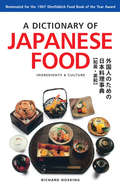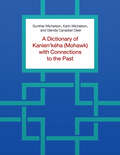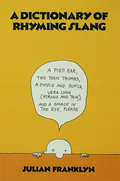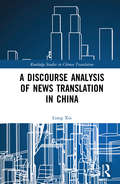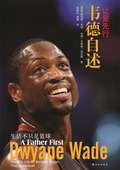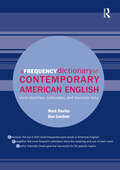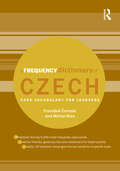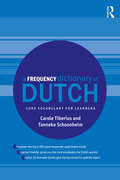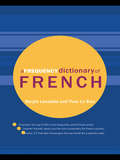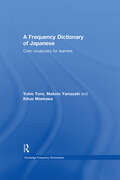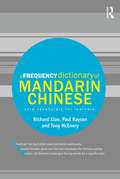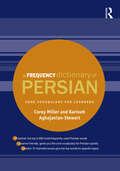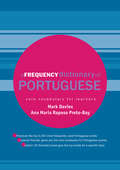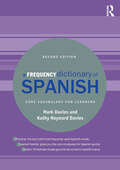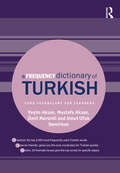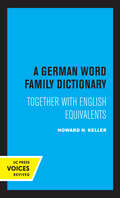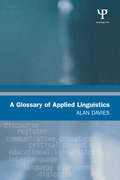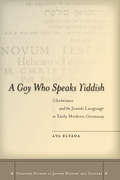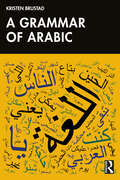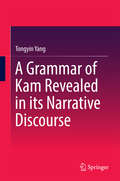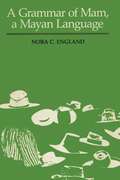- Table View
- List View
A Dictionary of Japanese Food: Ingredients & Culture
by Richard HoskingNominated for the Glenfiddich Food Book of the Year Award, this timeless volume is the first and only book of its kind on the subject.<P><P>A Dictionary of Japanese Food helps food lovers around the world decipher the intricacies and nuances of Japanese cooking and its ingredients. Definitions in ordinary cookbooks and standard dictionaries--such as akebia for akebi, sea cucumber for namako, plum for ume--can be inadequate, misleading, or just plain wrong. Richard Hoskings eliminates the mystery by ensuring that each entry in the Japanese-English section includes the Japanese term in Roman script; the term in kana or kanji or both; a Latin name where appropriate; an English definition; and, for most entries, a short annotation.The English-Japanese section defines important English food terms in Japanese and annotates those needing explanation. One hundred small line drawings make it easy for readers to identify everything from mitsuba to the okoze fish, and seventeen appendices address the most critical elements of Japanese cuisine, from the making of miso and the structure of the Japanese meal to the tea ceremony.
A Dictionary of Kanien’kéha (Mohawk) with Connections to the Past
by Karin Michelson Gunther Michelson Glenda Canadian DeerThis dictionary provides a record of the Kanien’kéha (Mohawk) language as spoken by fluent first- and second-language speakers at the Kanien’kéha Mohawk Territory outside of Montréal, Canada. The Kanien’kéha language has been written since the 1600s, and these dictionary entries include citations from published, archival, and informal writings from the seventeenth century onwards. These citations are a legacy of the substantial documents of missionary scholars and several informal vocabulary lists written by Kanien’kéha speakers, among others. The introduction to the dictionary provides a description of the organization and orthography of the historical works so that they can be used in the future by those studying and learning the language. A Dictionary of Kanien’kéha (Mohawk) with Connections to the Past allows scholars and students to learn the meaning, composition, and etymology of words in a language known for its particularly complex word structure. The organization of the entries, according to noun and verb roots, highlights the remarkable potential and adaptability of the language to express traditional concepts, as well as innovations that have resulted from contact with other customs and languages that have become part of the contemporary culture of the Kanien’kehá:ka.
A Dictionary of Rhyming Slang
by Julian FranklynThis re-issue of Julian Franklyn's classic dictionary not only defines these expressions but also explains their origin and history. An introductory essay examines the roots and development of rhyming slang. Although many people assume that rhyming slang is exclusively Cockney, Franklyn illustrates how it is common to Australian and Americn dialects. From the unlikely to the bizarre, the 1,500 entries both entertain and enlighten. Cartoons enliven a reference section which combines linguistic detail and cultural analysis. Whether reading the dictionary from cover to cover, or dipping into it as a reference tool, linguists and students of popular culture will find it the definitive source of information on rhyming slang.
A Discourse Analysis of News Translation in China (Routledge Studies in Chinese Translation)
by Liang XiaA Discourse Analysis of News Translation in China offers hitherto underexplored inroads into Chinese media through insider perspectives on a unique Chinese newspaper, Cankao Xiaoxia which not only is the largest circulating newspaper in China but is also unique in that its news consists entirely of stories translated from foreign news sources. The size of the publication, the unique nature of the publication, and the view from the inside of such an organization gathered through interviews with its employees give this proposed book a highly unique perspective that will inform our understanding of the workings of Chinese media in important ways.
A Father First (Mandarin Edition)
by Dwayne WadeDwyane Wade of the Miami Heat is one of the superstars of the NBA--and a Gold Medal winner at the Bejing Olympics--but he'sA Father First. In this moving and triumphant memoir, Wade shares his inspiring thoughts about fathers and sons, writing poignantly about the gratifying responsibilities of being a single dad to his two sons, Zaire and Zion, while recounting his own growing up years and his memorable rise to the top echelon of professional basketball. 德韦恩·韦德奇迹般地抓住了篮球生涯中的所有机遇 同时也在寻求他最珍爱的目标 做一个好父亲 经过了漫长,痛苦的离婚和监护权争夺战 他终于获得了儿子们的单独监护权 让爱先行 记录了韦德作为单身父亲的感悟 回忆了那些构成他的梦想,祈祷与承诺的事件 韦德从小父母离异 他的童年是在芝加哥南部度过的 贫穷,暴力,毒品笼罩着这片街区 他的母亲也吸毒成癖 姐姐特拉吉尔做出了英勇的决定 把小德韦恩送到了父亲那里生活 老韦德成了小德韦恩的第一个篮球教练 后来 母亲凭借惊人的毅力戒除了毒瘾 韦德从他们身上学习到 父母对子女无条件的爱是一股强大的引导力 从幼时在芝加哥邻家院子里的投篮练习 到他在马奎特大学的上升星路 再到出乎意料地被迈阿密热火队选中 德韦恩·韦德----世界上最好的篮球手之一 在 让爱先行 里讲述了自己的故事 男孩沐浴着亲人的爱成长为男人 成长为优秀的父亲
A Frequency Dictionary of Contemporary American English: Word Sketches, Collocates and Thematic Lists (Routledge Frequency Dictionaries)
by Mark Davies Dee GardnerFirst published in 2010 . Routledge is an imprint of Taylor & Francis, an informa company.
A Frequency Dictionary of Contemporary Arabic Fiction: Core Vocabulary for Learners and Material Developers (Routledge Frequency Dictionaries)
by Laila FamiliarA Frequency Dictionary of Contemporary Arabic Fiction provides a list of the top 2,000 words occurring in contemporary Arabic fiction. Based on a written corpus that contains 144 literary samples, the dictionary addresses key areas of Arabic language learning and teaching, including lexical frequency, reading skills, and Arabic literature. Each entry in the main frequency index includes a sample sentence, English translation, and frequency indicator, and alphabetical and part-of-speech indexes are provided for ease of use. The dictionary also contains 19 thematically organized and frequency-ranked lists of words on a variety of topics, such as food, places, emotions, and nature. Engaging and highly useful, this Frequency Dictionary is a valuable resource for students and instructors working in the area of TAFL, and for applied linguists interested in Arabic corpus linguistics.
A Frequency Dictionary of Czech: Core Vocabulary for Learners (Routledge Frequency Dictionaries)
by František Cermák Michal KrenA Frequency Dictionary of Czech is an invaluable tool for all learners of Czech, providing a list of the 5,000 most frequently used words in the language. Based on data from a 100 million word corpus and evenly balanced between spoken, fiction, non-fiction and newspaper texts, the dictionary provides the user with a detailed frequency-based list, as well as alphabetical and part of speech indexes. All entries in the rank frequency list feature the English equivalent, a sample sentence with English translation and an indication of register variation. The dictionary also contains twenty thematically organised and frequency-ranked lists of words on a variety of topics, such as family, food and drink and transport. A Frequency Dictionary of Czech enables students of all levels to get the most out of their study of vocabulary in an engaging and efficient way. It is also a rich resource for language teaching, research, curriculum design, and materials development. A CD version is available to purchase separately. Designed for use by corpus and computational linguists it provides the full text in a format that researchers can process and turn into suitable lists for their own research work.
A Frequency Dictionary of Dutch: Core Vocabulary for Learners (Routledge Frequency Dictionaries)
by Carole Tiberius Tanneke SchoonheimA Frequency Dictionary of Dutch is a valuable tool for all learners of Dutch, providing a list of the 5,000 most frequently used words in the language. Based on a 290 million word corpus which includes both written and spoken material from a wide range of sources, this dictionary presents Dutch core vocabulary in a detailed and clearly arranged manner: each of the 5,000 entries includes English equivalents and a sample sentence showing language in use. Users can access the top 5,000 words either through the main frequency listings or an alphabetical index. Throughout the frequency listings there are thematically organized lists featuring the top words from a variety of key topics such as animals, food and other areas of daily and cultural life. Words specific to Dutch in Belgium (Belgian Dutch) are also included. An engaging and efficient resource, A Frequency Dictionary of Dutch will enable students of all levels to get the most out of their study. This book was prepared in association with the Instituut voor Nederlandse Lexicologie (INL, Institute of Dutch Lexicology). A CD version is available to purchase separately. Designed for use by corpus and computational linguists, it provides the full text in a format that researchers can process and turn into suitable lists for their own research purposes.
A Frequency Dictionary of French: Core Vocabulary for Learners (Routledge Frequency Dictionaries)
by Deryle Lonsdale Yvon Le BrasA Frequency Dictionary of French is an invaluable tool for all learners of French, providing a list of the 5000 most frequently used words in the language. Based on a 23-million-word corpus of French which includes written and spoken material both from France and overseas, this dictionary provides the user with detailed information for each of the 5000 entries, including English equivalents, a sample sentence, its English translation, usage statistics, and an indication of register variation. Users can access the top 5000 words either through the main frequency listing or through an alphabetical index. Throughout the frequency listing there are thematically-organized lists of the top words from a variety of key topics such as sports, weather, clothing, and family terms. An engaging and highly useful resource, the Frequency Dictionary of French will enable students of all levels to get the most out of their study of French vocabulary. Deryle Lonsdale is Associate Professor in the Linguistics and English Language Department at Brigham Young University (Provo, Utah). Yvon Le Bras is Associate Professor of French and Department Chair of the French and Italian Department at Brigham Young University (Provo, Utah).
A Frequency Dictionary of German: Core Vocabulary for Learners (Routledge Frequency Dictionaries)
by Erwin Tschirner Jupp MöhringThis completely updated edition of A Frequency Dictionary of German contains the 5,000 most commonly used words of German today, occurring in a 20 million word corpus (compared to a 4.2 million corpus in the first edition). The basis of the frequency list is a significantly extended version of the Herder/BYU Corpus of Contemporary German. The Dictionary contains spoken and written German, and represents different genres, text types, registers, styles, and also regional varieties. The corpus is designed to represent the current German language as it is used in real world. Useful as a reference for students and course designers alike, A Frequency Dictionary of German is an important new resource.
A Frequency Dictionary of Japanese (Routledge Frequency Dictionaries)
by Yukio Tono Makoto Yamazaki Kikuo MaekawaA Frequency Dictionary of Japanese is an invaluable tool for all learners of Japanese, providing a list of the 5,000 most commonly used words in the language. Based on a100 million word corpus, composed of spoken, fiction, non-fiction and news texts in current use, the dictionary provides the user with a detailed frequency-based list, as well as alphabetical and part-of-speech indices. All entries in the frequency list feature the English equivalent and a sample sentence with English translation. The dictionary also contains 25 thematically organised lists of frequently used words on a variety of topics such as food, weather, occupations and leisure. Numerous bar charts are also included to highlight the phonetic and spelling variants across register. A Frequency Dictionary of Japanese enables students of all levels to maximise their study of Japanese vocabulary in an efficient and engaging way. It is also an excellent resource for teachers of the language.
A Frequency Dictionary of Korean: Core Vocabulary for Learners (Routledge Frequency Dictionaries)
by Sun-Hee Lee Seok Bae Jang Sang Kyu SeoA Frequency Dictionary of Korean is an invaluable tool for all learners of Korean, providing a list of the 5000 most frequently used words in the language. Based on the Sejong National Corpora, the largest written and spoken corpora in Korean comprised of 10 million words collected from different genres, the Dictionary provides the user with detailed information for each of the entries, including illustrative examples and English translations. The Dictionary provides a rich resource for language teaching and curriculum design, while a separate CD version provides the full text in a tab-delimited format ideally suited for use by corpus and computational linguists. With entries arranged both by frequency and alphabetically, A Frequency Dictionary of Korean enables students of all levels to get the most out of their study of vocabulary in an engaging and efficient way.
A Frequency Dictionary of Mandarin Chinese: Core Vocabulary for Learners (Routledge Frequency Dictionaries)
by Richard Xiao Paul Rayson Tony McEneryA Frequency Dictionary of Mandarin Chinese is an invaluable tool for all learners of Mandarin Chinese, providing a list of the 5,000 words and the 2,000 Chinese characters (simplified) most commonly used in the language. Based on a fifty-million-word corpus composed of spoken, fiction, non-fiction and news texts in current use, the dictionary provides the user with a detailed frequency-based list, as well as alphabetical and part-of-speech indexes. All entries in the frequency list feature the English equivalent and a sample sentence with English translation. The Dictionary also contains thirty thematically organized lists of frequently used words on a variety of topics such as food, weather, travel and time expressions. A Frequency Dictionary of Mandarin Chinese enables students of all levels to maximize their study of Mandarin vocabulary in an efficient and engaging way. It is also an excellent resource for teachers of the language. A CD version is available to purchase separately. Designed for use by corpus and computational linguists it provides the full text in a format that researchers can process and turn into suitable lists for their own research work.
A Frequency Dictionary of Persian: Core vocabulary for learners (Routledge Frequency Dictionaries)
by Corey Miller Karineh Aghajanian-StewartA Frequency Dictionary of Persian is an invaluable tool for all learners of Persian, providing a list of the 5,000 most frequently used words in the language. Based on a 150 million word corpus of written and spoken Persian texts from the Iranian world, the Dictionary provides the user with a detailed frequency-based list, plus alphabetical and part-of-speech indices. All entries feature the English equivalent, and an example of use in context. The Dictionary also features thematically-based lists of frequently used words on a variety of topics. Also featured are some grammatically-oriented lists, such as simple verbs and light verb constructions, and comparisons of different ways of expressing the months of the year. The Dictionary provides a rich resource for language teaching and curriculum design, while a separate CD version provides the full text in a tab-delimited format ideally suited for use by corpus and computational linguists. A Frequency Dictionary of Persian enables students of all levels to build on their study of Persian in an efficient and engaging way.
A Frequency Dictionary of Portuguese (Routledge Frequency Dictionaries)
by Mark Davies Ana Maria Preto-BayAn invaluable tool for learners of Portuguese, this Frequency Dictionary provides a list of the 5000 most commonly used words in the language. Based on a twenty-million-word collection of Portuguese (taken from both Portuguese and Brazilian sources), which includes both written and spoken material, this dictionary provides detailed information for each of the 5000 entries, including the English equivalent, a sample sentence, and an indication of register and dialect variation. Users can access the top 5000 words either through the main frequency listing or through an alphabetical index. Throughout the frequency listing there are also thrity thematically-organized ‘boxed’ lists of the top words from a variety of key topics such as sports, weather, clothing and relations. An engaging and highly useful resource, A Frequency Dictionary of Portuguese will enable students of all levels to get the most out of their study of Portuguese vocabulary. Former CD content is now available to access at www.routledge.com/9780415419970 as support material. Designed for use by corpus and computational linguists it provides the full text in a format that researchers can process and turn into suitable lists for their own research work.
A Frequency Dictionary of Russian: core vocabulary for learners (Routledge Frequency Dictionaries)
by James Wilson Serge Sharoff Elena UmanskayaA Frequency Dictionary of Russian is an invaluable tool for all learners of Russian, providing a list of the 5,000 most frequently used words in the language and the 300 most frequent multiword constructions. The dictionary is based on data from a 150-million-word internet corpus taken from more than 75,000 webpages and covering a range of text types from news and journalistic articles, research papers, administrative texts and fiction. All entries in the rank frequency list feature the English equivalent, a sample sentence with English translation, a part of speech indication, indication of stress for polysyllabic words and information on inflection for irregular forms. The dictionary also contains twenty-six thematically organised and frequency-ranked lists of words on a variety of topics, such as food and drink, travel, and sports and leisure. A Frequency Dictionary of Russian enables students of all levels to get the most out of their study of vocabulary in an engaging and efficient way. It is also a rich resource for language teaching, research, curriculum design, and materials development. A CD version is available to purchase separately. Designed for use by corpus and computational linguists it provides the full text in a format that researchers can process and turn into suitable lists for their own research purposes.
A Frequency Dictionary of Spanish: Core Vocabulary for Learners (Routledge Frequency Dictionaries Ser.)
by Mark Davies Kathy Hayward DaviesA Frequency Dictionary of Spanish has been fully revised and updated, including over 500 new entries, making it an invaluable resource for students of Spanish. Based on a new web-based corpus containing more than 2 billion words collected from 21 Spanish-speaking countries, the second edition of A Frequency Dictionary of Spanish provides the most expansive and up-to-date guidelines on Spanish vocabulary. Each entry is accompanied with an illustrative example and full English translation. The Dictionary provides a rich resource for language teaching and curriculum design, while a separate CD version provides the full text in a tab-delimited format ideally suited for use by corpus and computational linguistics. With entries arranged both by frequency and alphabetically, A Frequency Dictionary of Spanish enables students of all levels to get the most out of their study of vocabulary in an engaging and efficient way.
A Frequency Dictionary of Turkish: Core Vocabulary For Learners (Routledge Frequency Dictionaries)
by Yeşim Aksan Mustafa Aksan Ümit Mersinli Umut DemirhanA Frequency Dictionary of Turkish enables students of all levels to build on their study of Turkish in an efficient and engaging way. <P><P> Based on a 50 million word corpus, A Frequency Dictionary of Turkish provides a list of core vocabulary for learners of Turkish as a second or foreign language. It gives the most updated, reliable frequency guidelines for common vocabulary in spoken and written Turkish. Each of the 5000 entries are supported by detailed information including the English equivalent, an illustrative example with English translation and usage statistics. The Dictionary provides a rich resource for language teaching and curriculum design, while a separate CD version provides the full text in a tab-delimited format ideally suited for use by corpus and computational linguists. With entries arranged by frequency, by suffixation and alphabetically, A Frequency Dictionary of Turkish enables students of all levels to get the most out of their study of vocabulary in an engaging and efficient way.
A German Word Family Dictionary: Together with English Equivalents
by Howard H. KellerThis title is part of UC Press's Voices Revived program, which commemorates University of California Press’s mission to seek out and cultivate the brightest minds and give them voice, reach, and impact. Drawing on a backlist dating to 1893, Voices Revived makes high-quality, peer-reviewed scholarship accessible once again using print-on-demand technology. This title was originally published in 1978.
A Glossary of Applied Linguistics
by Alan DaviesApplied Linguistics is still a growing field. Key texts and handbooks have appeared in recent years and international applied linguistics conferences and professional associations occur regularly. While Applied Linguistics continues to attract new entrants and to generate new strands of research, there is a need for a clear and concise map of the field. This is the purpose of the Glossary.The author, Alan Davies, is a well-established, well-published authority on applied linguistics. Not a typically dry dictionary, Dr. Davies infuses the alphabetical entries with a touch of humor and thought-provoking context creating an up-to-date, useful, and coherent view of applied linguistics.The Glossary compiles the most ubiquitously used terms in applied linguistics and teacher-training literature. It takes a wide-ranging view of the field, drawing not only on linguistics but including psychology, sociology, education, measurement theory, speech therapy, translation, and language planning. Other features include:*numerous cross-references to key terms;*an introduction, which discusses the difficulty of defining applied linguistics; and*a brief reading list of key text.The primary market is master's student in Applied Linguistics, Second Language Acquisition, and TESL/TEFL. Undergraduate students, particularly in language fields and in education will also find it helpful, as well as language teachers who have not themselves followed Applied Linguistics courses and who are interested in finding out about the field.
A Goy Who Speaks Yiddish: Christians and the Jewish Language in Early Modern Germany
by Aya ElyadaThis book explores the unique phenomenon of Christian engagement with Yiddish language and literature from the beginning of the sixteenth century to the late eighteenth century. By exploring the motivations for Christian interest in Yiddish, and the differing ways in which Yiddish was discussed and treated in Christian texts,A Goy Who Speaks Yiddishaddresses a wide array of issues, most notably Christian Hebraism, Protestant theology, early modern Yiddish culture, and the social and cultural history of language in early modern Europe. Elyada's analysis of a wide range of philological and theological works, as well as textbooks, dictionaries, ethnographical writings, and translations, demonstrates that Christian Yiddishism had implications beyond its purely linguistic and philological dimensions. Indeed, Christian texts on Yiddish reveal not only the ways in which Christians perceived and defined Jews and Judaism, but also, in a contrasting vein, how they viewed their own language, religion, and culture.
A Grammar of Arabic
by Kristen BrustadA Grammar of Arabic models a new framework for studying varieties of Arabic comparatively, highlighting the patterns of variation and consistency, and showing how different styles, from primarily spoken and casual to primarily written and formal, are linguistically interrelated.This non-traditional reference grammar is structured around patterns of usage rather than prescriptive rules, aligning function with form and taking advantage of general principles of language. Using data from Classical Arabic, Arabic, Modern Standard Arabic, and dialects spoken in Morocco, Egypt, Sudan, the Levant, Iraq, and the Arabian Gulf, this grammar examines the actual usage of these language varieties, broadening understanding of Arabic dialects from a linguistics perspective while also giving readers the ability to engage language diversity.Designed for instructors, researchers, and advanced students of Arabic, A Grammar of Arabic explores Arabic from an internally comparative perspective that will also be valuable to theoretical linguists.
A Grammar of Kam Revealed in Its Narrative Discourse
by Tongyin YangThe Kam language of China possesses fifteen tones - more than any other language. Yet it has long been neglected as an area of research, especially from the perspective of discourse analysis. This study initiates the exploration of the interface between grammar and discourse by examining various aspects of Kam narrative discourse, and using a functional approach to reveal its structural properties. It also introduces the mechanism for phonological and syntactic variations, as well as classifier variants and sentence-final particles (SFPs) in discourse and word order variations. Finally, it discusses the influence of social setting on narrative structure and offers the most up-to-date ethnological and social information about the community.
A Grammar of Mam, a Mayan Language
by Nora C. EnglandThis is the first full-length reference grammar of Mam, a Mayan language spoken today by over 400,000 people in the western highlands of Guatemala and the state of Chiapas, Mexico. The result of over three years of extensive fieldwork in Guatemala, A Grammar of Mam, a Mayan Language is based on the dialect of Mam spoken by 12,000 people in San Ildefonso Ixtahuacan in the department of Huehuetenango, Guatemala. England organizes A Grammar of Mam according to two complementary principles: to analyze Mam following basically traditional levels of grammatical description and to present material in such a way that the background information necessary for understanding each topic of discussion shall have been previously provided. Accordingly, England's analysis of the sound system and morphophonemic processes of Mam is followed by a description of the characteristics of root, inflectional, and derivational morphology. Chapters on phrase structure precede two chapters on sentence-level syntax. A Grammar of Mam is of particular interest in analyzing a Mayan language that is both syntactically and morphologically ergative and that is innovative in the direction of strengthening the ergative system. Indeed at all levels of linguistic organization Mam is innovative, and for this reason it is uniquely interesting both historically and theoretically.
